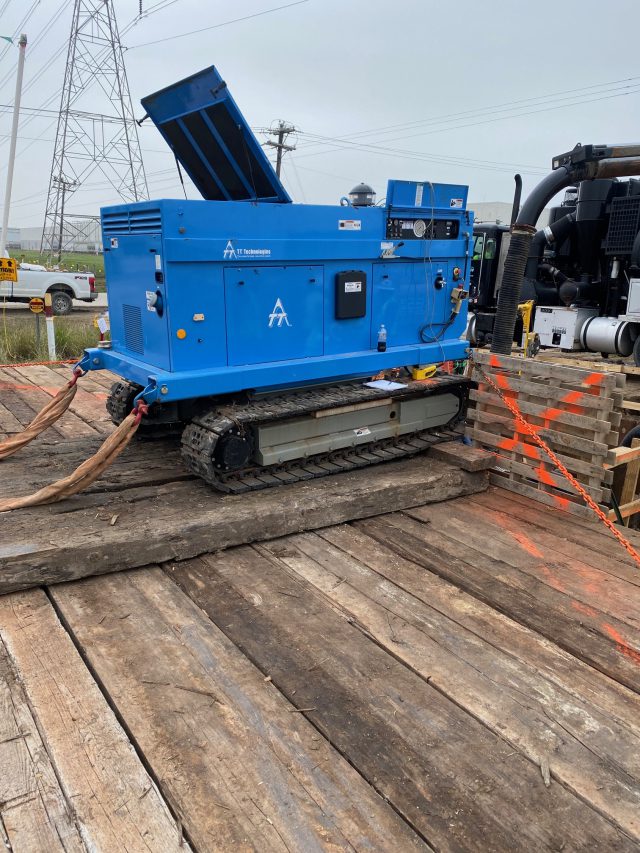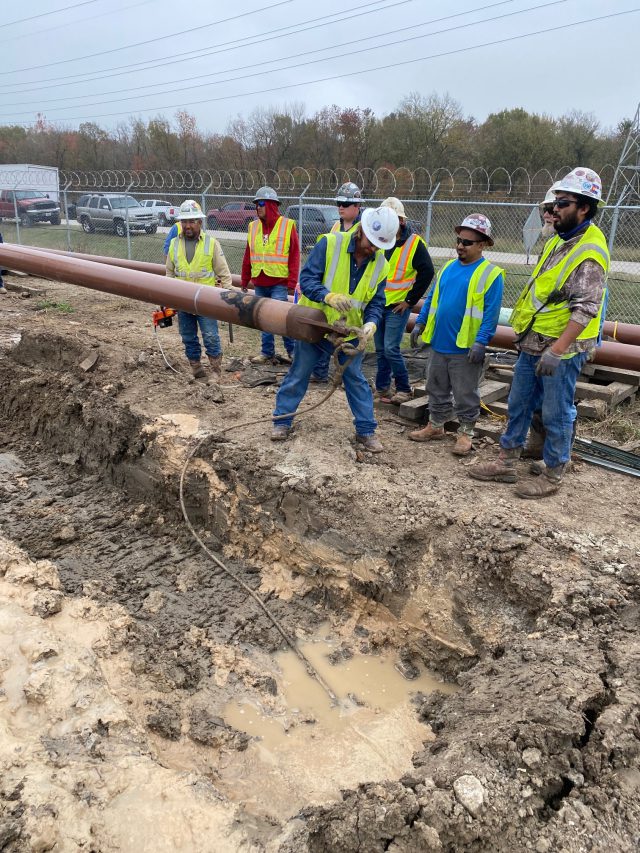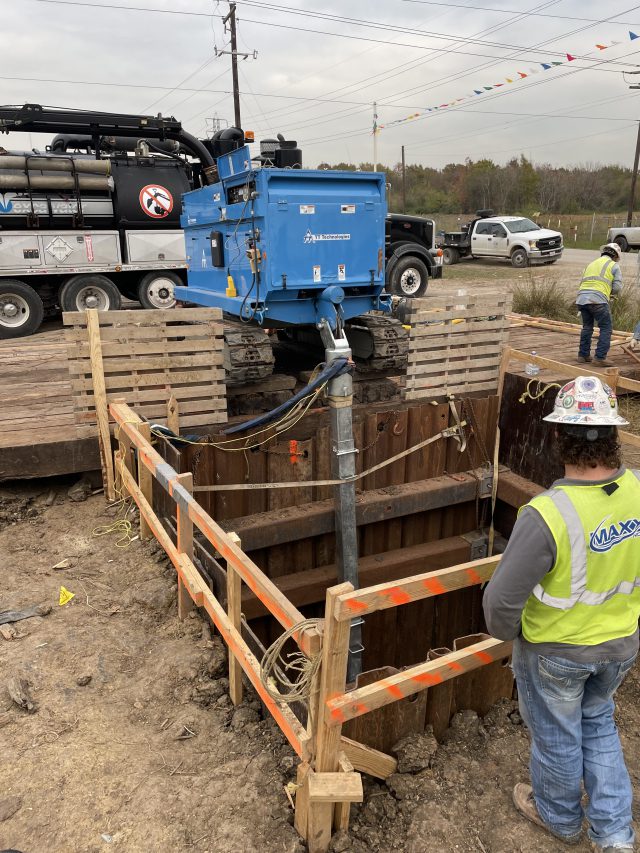Originally posted on TT Technologies
The replacement and upgrading of a wide range of infrastructure by the oil and gas industry is a process that is happening all the time. In areas throughout the United States, energy utilities are working diligently to update or install new infrastructure at every level. To facilitate new services, mains, transmission pipelines and storage facilities, the industry aligned itself early on with trenchless applications and contractors, and, in many cases, has been a driving force in the growth of that technology as well. But even with the vast number of trenchless resources available, sometimes a little creativity is needed to get the job done.
That was the case for trenchless contractor MAXX HDD, Navasota, Texas on a recent pipeline corridor project in Baytown, TX. The multifaceted trenchless contractor was selected to install a new carrier pipe for a storage field facility. However, because of the difficult jobsite layout, how that would be accomplished was not immediately evident.
According to MAXX HDD Chief Operating Officer TJ Strickland the project presented several significant challenges. He said, “It was on a pipeline corridor. It’s a very congested corridor that runs through Houston, down to the Baytown area. There are facilities and pipelines everywhere. The project was part of the development of a new storage facility. We were subcontracted to install the 450-foot, 8-inch diameter steel pipeline that would get the product into or out of the new facility. Typically, this would have been a directional drilling project. However, the tight work area and job requirements did not allow us to pullback the product pipe in a traditional manner.”
Without the ability to use the drill to pull in the new pipe, Strickland and his team needed to find another option for installing the pipe. The jobsite layout had the MAXX HDD crew drilling into a 26-foot-deep pit where the new carrier pipe would be connected to the rest of the system. The problem was there was no room to stage the pipe for pullback near the pit or even reposition the drill in that area.
Strickland said, “Thinking out of the box, we had to come up with something to facilitate getting the pipe in the ground. We met with the project owner, the engineers and other partners trying to just come up with different ways to do it. Rick Melvin [TT Technologies, Aurora, Ill.] mentioned the possibility of using a trenchless winch, stationed at the pit to pull in the pipe. So, I said, ‘Let’s get some paperwork on it.’ And we did and I sent it over for review and everyone thought it looked like that could work!”
Melvin a Trenchless Specialist with trenchless equipment manufacturer TT Technologies is no stranger to pairing trenchless technologies to make difficult projects happen. He said, “Like TJ said, this was thinking about things differently to find a solution. The drill rig would do part of the job and the winch would finish it off. The Grundowinch we used on the job is typically paired with a pneumatic pipe bursting tool but has many other applications as well. It can pull pipe, conduit, swage line any number of things. It’s called the ‘trenchless winch’ and that’s accurate. Having a highly skilled contractor like MAXX HDD, however, is what made this project work.”
MAXX HDD- Max Skill, Max Safety, Max Results
Founded in 2015, MAXX HDD is a respected leader in the trenchless construction industry. The privately owned company is led by an ownership group and management team comprised of second and third generation industry experts.
Strickland said, “So we started the company in 2015. My other two business partners come from pipeline background as well. We just wanted to build something that we could stand behind, that was privately owned, and make it really special for a small group of folks and it took off. We’ve got a really good core group of guys. One of or supervisors has got over a million feet of pipe installed in his career. He is absolutely a plethora of knowledge.”
According to Strickland, safety is a key part of the culture at MAXX HDD. He continued, “The safety of our employees is really at the top of the list and it’s part of everything we do. From extensive training to identifying hazards on the job site before they happen and allowing employees to voice safety concerns, it becomes part of everything we do. It’s not taken lightly.”
Drilling Out
MAXX HDD was subcontracted to install approximately 450 feet of an 8-inch diameter steel pipe. Without the ability to pullback the new pipe, crews had to drill out to the pit and create a hole so the new pipe could be pulled with the 20-ton winch. That began with a 5-inch pilot bore and transitioned to backreaming.
Strickland said, “With this one we had to drill, prepare the hole, move the rig out of the way. We used a 100,000-lb. HDD rig for the bore path. We piloted it out, opened the hole and punched out in the bottom of the box. There were pipelines everywhere some that were very close to us. Several of them we exposed in that pit structure itself. The plan was to get the pipe in place and the general contractor would take it from there.”
Soil conditions were wet “Baytown clay” and crews needed to keep the submersible dewatering pump in the pit running constantly to keep the ground water under control. The seven-man crew spent two days completing the pilot bore and another two days backreaming.
Strickland said, “With all that other pipeline out there the pilot had to be dead on the money and it came in perfectly. After the pilot bore, we went straight to a 16-inch fly cutter backreamer. We cut a 16-inch hole to make sure we had plenty of room. We left our steering tool in the system down hole so we could make sure that the reamer wasn’t cutting too far out of the hole. And then we pushed the reamer back across to keep that hole open. On the last pass we made through there, we pulled back the Grundowinch cable and moved our drilling rig out of the way.”
Pipe Pulling Power & Precision
With the Grundowinch positioned above the target pit and the winch cable pulled through the bore hole, crews began preparing the product for pullback. Melvin said, “Constant-tension winches are built to handle ever-changing conditions in below-grade work. You hear about constant-tension and variable. And that is one thing that sets this winch apart from others. That design feature means any cable slack is sensed by the winch and taken up quickly and automatically. This makes for an ideal winch for sensitive operations such as swage lining. Obviously, the adjustable boom came into play here. It needed to be extended almost 25 feet in order to make this pull work.”
Again, the tight working area forced the crew to pull back the new pipe in sections, rather than staging the entire 450 feet and pulling it back all at once. Strickland said, “There was a lot of new construction going on right there and we were kind of pinned up against a parking lot. So, we started with 150 feet of pipe and welded one of our regular pulling heads on the first section of pipe. We had 14-degree entry angle and used pipe rollers to make the pullback as easy as possible. We pulled the first 150-foot section in about 45 minutes and then we welded on the next segment, approximately 170 feet. Then we pulled that out and made the second weld to the final section of pipe.”
All welds were x-rayed, and special monitoring was done to ensure that there was no damage to the pipe coating during installation. To everyone’s satisfaction, pulling in the carrier using the 20-ton constant-tension winch proved to be very successful.
Strickland said, “Once we got our winch unhooked from it, we cleaned up our mess, got our stuff loaded up and get out of there. After the general contractor made the tie in, they cut off our pull head and shipped it back to us a week or two later. I think we had about nine days total on the job. That’s from the time we hit the ground, until the time we completely demobilized and got out of there.”



